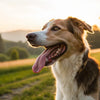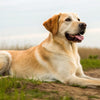Understanding How Long Dogs Pant After Exercise and How to Help Them Cool Down
- Houndsy
Table of Contents
- Introduction
- The Science Behind Panting
- Recognizing Excessive Panting
- Effective Cooling Techniques
- The Role of Diet in Recovery
- Conclusion
- FAQ
Introduction
As devoted pet owners, we often find ourselves captivated by the sheer joy and enthusiasm our dogs exhibit during playtime or vigorous exercise. Did you know that dogs can take between 10 to 30 breaths per minute, depending on their size and activity level? This fact highlights the natural physiological responses dogs experience during and after physical activity. However, as much as we love our pets, it’s crucial to understand their needs, particularly when it comes to cooling down after exercise.
When our furry companions engage in vigorous activities, panting—an essential mechanism for dogs to regulate their body temperature—becomes a common sight. But how long do dogs pant after exercise, and what does it mean for their health? By the end of this post, we aim to provide you with comprehensive insights into the panting process, its implications, and effective cooling techniques to ensure the well-being of our canine friends.
In this post, we will explore the physiological reasons behind panting, the expected duration of panting after exercise, signs of excessive panting, and best practices for cooling down our dogs. We invite you to reflect on your own dog's post-exercise behavior and consider how you can enhance their recovery routine. Let’s dive into the world of our beloved pets and learn how to better care for them during their cooling-down period.
The Science Behind Panting
Why Do Dogs Pant?
Panting is a natural behavior for dogs, serving as an essential mechanism for thermoregulation. Unlike humans, dogs do not have sweat glands distributed throughout their bodies; instead, they rely on panting to cool off. When a dog pants, it increases airflow over the moist surfaces of their tongue and respiratory tract, dissipating heat and helping to lower their core body temperature.
In addition to temperature regulation, panting can occur in response to various emotional states, such as excitement, anxiety, or stress. Understanding the context of your dog's panting is crucial in determining whether it is a normal response to exercise or indicative of something more serious.
Normal Panting After Exercise
After engaging in physical activity, it is completely normal for dogs to pant. The length of time it takes for a dog to return to their normal breathing rate can vary based on several factors, including:
- Exercise Intensity: Higher intensity workouts result in longer panting durations.
- Dog's Age and Breed: Younger, more active breeds may recover faster than older or brachycephalic breeds (like Bulldogs and Pugs) that are more prone to respiratory issues.
- Environmental Conditions: Hot and humid weather can contribute to prolonged panting.
Generally, most dogs will pant for about 10 to 30 minutes after moderate to intense exercise. Observing your dog’s typical panting behavior during this time will help you identify any changes that may signal distress.
Recognizing Excessive Panting
Signs of Concern
While panting is a normal response to exercise, it’s essential to differentiate between typical panting and excessive panting that could indicate a health issue. Here are some signs to watch for:
- Duration: If your dog continues to pant heavily for more than 30 minutes after resting, this could be a cause for concern.
- Intensity: Excessive panting that is labored or accompanied by other symptoms—such as drooling, weakness, or disorientation—may require veterinary attention.
- Environmental Changes: If your dog is panting excessively in a cool environment, this could signal distress or underlying health conditions.
Potential Health Issues
Excessive panting can be a symptom of several medical conditions, including:
- Heatstroke: A critical condition caused by overheating, often accompanied by extreme panting, drooling, and confusion.
- Heart or Respiratory Problems: Conditions such as heart failure or chronic obstructive pulmonary disease (COPD) can lead to abnormal panting patterns.
- Anxiety or Stress: Situational stressors, such as thunderstorms or loud noises, may result in increased panting as well.
If you notice any of these concerning signs, it’s crucial to contact your veterinarian for guidance.
Effective Cooling Techniques
Hydration Is Key
One of the simplest yet most effective ways to help your dog cool down after exercise is to ensure they stay hydrated. Always bring water along during walks or play sessions, and offer small amounts frequently rather than allowing them to gulp large quantities at once.
Gradual Cool Down
Just as we benefit from a cool-down period after exercise, dogs do too. Gradually slowing down the pace of their activity toward the end of a workout can significantly help. Instead of abruptly stopping, take a few minutes to walk at a slower pace, allowing their heart rates to decrease gradually.
Cooling Techniques to Implement at Home
- Wet Towels: After a workout, consider wetting a towel with cool (not ice-cold) water and draping it over your dog’s shoulders or back. The evaporation of water will help cool their body temperature.
- Cool Baths: If your dog enjoys water, a shallow cool bath can also be an effective way to help them cool down. Ensure the water is comfortable and not too cold, as this can shock their system.
- Fans and Air Conditioning: If you’re indoors, ensure your dog has access to a cool room with a fan or air conditioning. Creating a comfortable environment is vital for their recovery.
Monitoring Recovery Time
After implementing these cooling techniques, monitor your dog's breathing. Ideally, you should see their panting decrease within 10 to 30 minutes as they recover. Keep an eye on their behavior and energy levels during this time to ensure they are returning to normal.
The Role of Diet in Recovery
Post-Exercise Nutrition
After a good workout, your dog will likely be hungry. However, it’s essential to wait until they have cooled down before offering food. Feeding your dog immediately after exercise can lead to digestive issues or even bloat.
Instead, allow them to rest and hydrate before serving their regular meal. If you’re considering snacks or treats, opt for something light and easy to digest that can help replenish their energy without overwhelming their system.
Quality Food Matters
Providing high-quality dog food that meets your pet's nutritional needs plays a crucial role in their overall health and recovery. At Houndsy, we believe that every aspect of pet care should be elevated, including diet. Investing in a balanced diet can enhance your dog's energy levels and recovery time, ensuring they are always ready for the next adventure.
Conclusion
Understanding how long dogs pant after exercise and the underlying reasons for their panting is essential for every pet owner. By recognizing the signs of normal versus excessive panting, we can take proactive steps to ensure our dogs are healthy and comfortable during their recovery periods.
Incorporating effective cooling techniques, monitoring hydration, and providing a balanced diet will significantly enhance your pet's overall well-being. As responsible pet owners, it is our duty to advocate for our furry friends’ health and happiness.
Consider reflecting on your current post-exercise routine for your dog. Are there ways you can enhance their cooling process? Perhaps implementing a better hydration strategy or ensuring a comfortable resting environment? We encourage you to explore our Houndsy Kibble Dispenser, designed to streamline your dog’s feeding experience, making it not only convenient but also aesthetically pleasing in your home. Order Now.
FAQ
How long should my dog pant after exercise?
Dogs typically pant for about 10 to 30 minutes after moderate to vigorous exercise. The duration can vary based on the intensity of the activity and the individual dog's health.
What are the signs of excessive panting?
Excessive panting may include heavy breathing that lasts longer than 30 minutes, labored breathing, drooling, weakness, or signs of disorientation.
How can I help my dog cool down after exercise?
Ensure your dog is hydrated, allow them to gradually slow down their activity, and use wet towels or cool baths to help lower their body temperature.
When should I be concerned about my dog's panting?
If your dog's panting is excessive and does not improve within 30 minutes, or if you observe other concerning symptoms like pale gums or lethargy, contact your veterinarian immediately.
Can I feed my dog immediately after exercise?
It's best to allow your dog to cool down and hydrate before offering food to prevent digestive issues or bloat.












